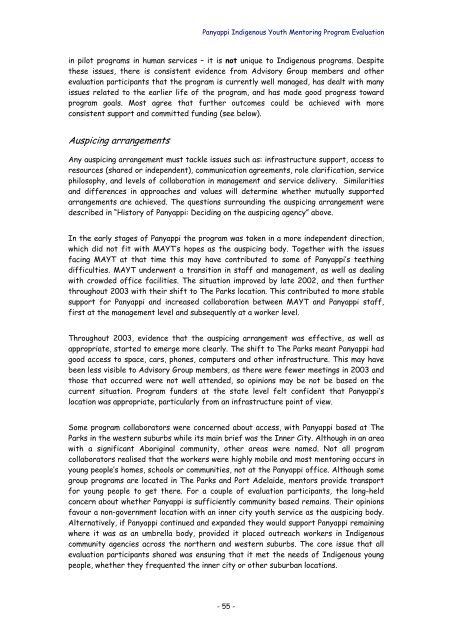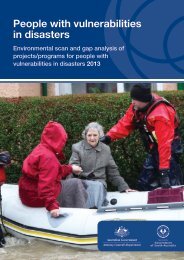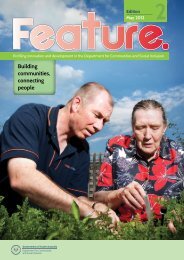Panyappi Indigenous Youth Mentoring Program Evaluation
Panyappi Indigenous Youth Mentoring Program Evaluation
Panyappi Indigenous Youth Mentoring Program Evaluation
Create successful ePaper yourself
Turn your PDF publications into a flip-book with our unique Google optimized e-Paper software.
<strong>Panyappi</strong> <strong>Indigenous</strong> <strong>Youth</strong> <strong>Mentoring</strong> <strong>Program</strong> <strong>Evaluation</strong><br />
in pilot programs in human services – it is not unique to <strong>Indigenous</strong> programs. Despite<br />
these issues, there is consistent evidence from Advisory Group members and other<br />
evaluation participants that the program is currently well managed, has dealt with many<br />
issues related to the earlier life of the program, and has made good progress toward<br />
program goals. Most agree that further outcomes could be achieved with more<br />
consistent support and committed funding (see below).<br />
Auspicing arrangements<br />
Any auspicing arrangement must tackle issues such as: infrastructure support, access to<br />
resources (shared or independent), communication agreements, role clarification, service<br />
philosophy, and levels of collaboration in management and service delivery. Similarities<br />
and differences in approaches and values will determine whether mutually supported<br />
arrangements are achieved. The questions surrounding the auspicing arrangement were<br />
described in “History of <strong>Panyappi</strong>: Deciding on the auspicing agency” above.<br />
In the early stages of <strong>Panyappi</strong> the program was taken in a more independent direction,<br />
which did not fit with MAYT’s hopes as the auspicing body. Together with the issues<br />
facing MAYT at that time this may have contributed to some of <strong>Panyappi</strong>’s teething<br />
difficulties. MAYT underwent a transition in staff and management, as well as dealing<br />
with crowded office facilities. The situation improved by late 2002, and then further<br />
throughout 2003 with their shift to The Parks location. This contributed to more stable<br />
support for <strong>Panyappi</strong> and increased collaboration between MAYT and <strong>Panyappi</strong> staff,<br />
first at the management level and subsequently at a worker level.<br />
Throughout 2003, evidence that the auspicing arrangement was effective, as well as<br />
appropriate, started to emerge more clearly. The shift to The Parks meant <strong>Panyappi</strong> had<br />
good access to space, cars, phones, computers and other infrastructure. This may have<br />
been less visible to Advisory Group members, as there were fewer meetings in 2003 and<br />
those that occurred were not well attended, so opinions may be not be based on the<br />
current situation. <strong>Program</strong> funders at the state level felt confident that <strong>Panyappi</strong>’s<br />
location was appropriate, particularly from an infrastructure point of view.<br />
Some program collaborators were concerned about access, with <strong>Panyappi</strong> based at The<br />
Parks in the western suburbs while its main brief was the Inner City. Although in an area<br />
with a significant Aboriginal community, other areas were named. Not all program<br />
collaborators realised that the workers were highly mobile and most mentoring occurs in<br />
young people’s homes, schools or communities, not at the <strong>Panyappi</strong> office. Although some<br />
group programs are located in The Parks and Port Adelaide, mentors provide transport<br />
for young people to get there. For a couple of evaluation participants, the long-held<br />
concern about whether <strong>Panyappi</strong> is sufficiently community based remains. Their opinions<br />
favour a non-government location with an inner city youth service as the auspicing body.<br />
Alternatively, if <strong>Panyappi</strong> continued and expanded they would support <strong>Panyappi</strong> remaining<br />
where it was as an umbrella body, provided it placed outreach workers in <strong>Indigenous</strong><br />
community agencies across the northern and western suburbs. The core issue that all<br />
evaluation participants shared was ensuring that it met the needs of <strong>Indigenous</strong> young<br />
people, whether they frequented the inner city or other suburban locations.<br />
- 55 -












